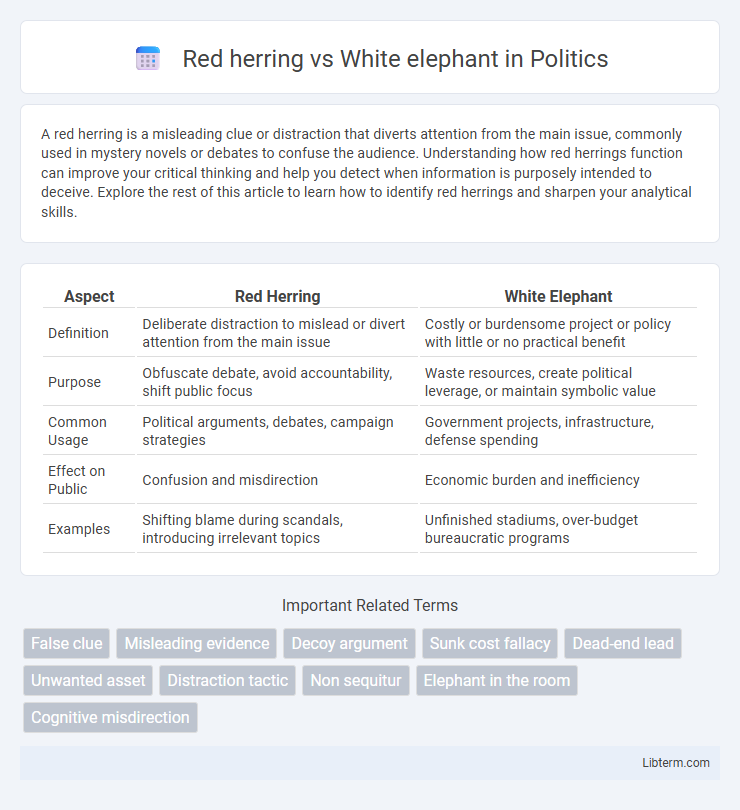A red herring is a misleading clue or distraction that diverts attention from the main issue, commonly used in mystery novels or debates to confuse the audience. Understanding how red herrings function can improve your critical thinking and help you detect when information is purposely intended to deceive. Explore the rest of this article to learn how to identify red herrings and sharpen your analytical skills.
Table of Comparison
| Aspect | Red Herring | White Elephant |
|---|---|---|
| Definition | Deliberate distraction to mislead or divert attention from the main issue | Costly or burdensome project or policy with little or no practical benefit |
| Purpose | Obfuscate debate, avoid accountability, shift public focus | Waste resources, create political leverage, or maintain symbolic value |
| Common Usage | Political arguments, debates, campaign strategies | Government projects, infrastructure, defense spending |
| Effect on Public | Confusion and misdirection | Economic burden and inefficiency |
| Examples | Shifting blame during scandals, introducing irrelevant topics | Unfinished stadiums, over-budget bureaucratic programs |
Introduction to Red Herring and White Elephant
Red herring and white elephant are common idiomatic expressions used in discussions of argumentation and problem-solving. A red herring refers to a distraction or misleading clue intended to divert attention from the main issue. A white elephant describes an object, project, or investment that is costly and burdensome but holds little practical value.
Defining the Red Herring: Meaning and Origins
A red herring is a misleading clue or distraction intended to divert attention from the main issue, often used in literature, debates, and investigations. Its origin traces back to 1800s Britain where smoked red herrings, having a strong scent, were allegedly used to mislead hunting dogs during training exercises. This metaphor has evolved to describe any tactic that intentionally leads audiences away from the truth or relevant information.
Understanding the White Elephant: History and Significance
The White Elephant originates from Southeast Asian royal traditions, where rare albino elephants were considered sacred and symbolized immense wealth and power, yet their upkeep was costly and burdensome. This historical context transformed the term into a metaphor for possessions that are more troublesome than valuable. Understanding the White Elephant highlights its dual significance as both a status symbol and a cautionary emblem against impractical extravagance.
Key Differences: Red Herring vs White Elephant
Red Herring refers to a misleading clue or distraction that diverts attention from the main issue, often used in literature or debates to confuse or mislead audiences. White Elephant denotes a possession that is burdensome due to its high cost of maintenance or impracticality, despite being valuable or prestigious. The key difference lies in their functions: Red Herring is a deliberate misdirection affecting perception, whereas White Elephant is an actual object causing economic or social burden.
Red Herring in Literature and Media
Red herring is a literary device used to mislead readers or viewers by introducing false clues that distract from the true plot or mystery, enhancing suspense and engagement. Common in mystery novels, films, and detective stories, red herrings create complex narratives by diverting attention from key evidence or true culprits. This technique keeps audiences uncertain and intrigues them in untangling the storyline, making it a powerful tool in suspenseful storytelling.
White Elephant in Culture and Traditions
White Elephant gifts embody cultural significance rooted in Southeast Asian traditions, symbolizing rare and valuable possessions often burdensome to maintain. This concept influences modern holiday gift exchanges, where items exchanged are humorous or impractical, fostering social interaction and entertainment. Understanding the white elephant tradition reveals insights into cultural values around generosity, humor, and communal bonding.
Common Uses in Modern Language
Red herring is commonly used in modern language to describe a distraction or misleading clue that diverts attention from the main issue, often found in mystery novels, debates, and political rhetoric. White elephant refers to an object, project, or possession that is costly to maintain and difficult to dispose of, frequently used to describe burdensome gifts or large-scale ventures like infrastructure projects with low utility. Both terms have become essential in everyday conversations to highlight deceptive tactics or impractical burdens.
Impact on Problem-Solving and Decision-Making
Red herrings disrupt problem-solving by introducing irrelevant information that misleads attention from the core issue, causing decision-makers to pursue false leads and waste resources. White elephants, in contrast, burden decision-making with costly, underperforming commitments that drain resources and hinder the ability to allocate efforts effectively toward viable solutions. Both affect strategic outcomes, but red herrings obscure understanding while white elephants impose tangible constraints on progress.
Examples Illustrating Each Term
A red herring example occurs in a mystery novel where a suspicious character is introduced to divert readers from the real culprit, such as the misleading clues in Agatha Christie's "Murder on the Orient Express." A white elephant example involves the construction of a costly, underused stadium, like the Olympic venues in Athens 2004, which became financial burdens with minimal practical use. Both terms highlight different types of distractions: red herrings mislead by deception, while white elephants burden through wastefulness.
Conclusion: Navigating Figurative Language
Understanding the distinctions between red herrings and white elephants enhances critical reading and communication skills by clarifying misleading distractions versus burdensome possessions. Mastery of these figurative expressions supports effective decision-making and argument analysis. Recognizing their unique implications allows for more precise interpretation in diverse contexts.
Red herring Infographic

 libterm.com
libterm.com